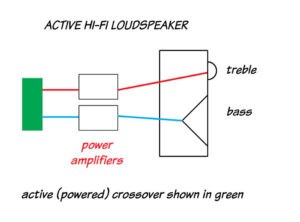No, it’s not the title of the latest Richard Curtis rom-com. Passive, active and single refer to the three primary ways of designing hi-fi and studio loudspeakers.
Most loudspeakers feature multiple drive units, each of which has a restricted bandwidth. For instance, in a typical two-way design the bass/mid unit may cover 50 Hz to 3000 Hz and a tweeter will take over from 3000 Hz. The two units are connected to the amplifier via a crossover; exactly how this is arranged determines whether the speaker is classed as a passive or active design.
By contrast, a single, full-range speaker such as the Jordan Marlow uses one drive unit which covers the whole frequency range, without the use of any crossover.
All three have advantages and disadvantages – the art of successful speaker design is knowing which compromises are acceptable and designing accordingly.
PASSIVE LOUDSPEAKER
These dominate the hi-fi market. They use passive (non-powered) crossovers featuring components designed to operate at tens of volts and high current. This makes the components large and expensive, particularly if close-tolerance parts are used. Even at relatively low power levels, the components can exhibit significant harmonic distortion which would be deemed unacceptable in an amplifier or other electronic hi-fi component. Furthermore, at higher power, the components can heat up, the actual component values can change and the crossover point will no longer be at the optimum frequency.
Finally, the crossover appears after the power amplifier, and effectively decouples the drive units from the amplifier, allowing no electrical damping and control over the movement of the cone or dome.
ACTIVE LOUDSPEAKER
These are a huge improvement over passive loudspeakers. The crossover is powered, like a preamplifier, and uses small voltage components, making them cheaper, closer tolerance and cooler running. An active crossover can be designed and manufactured much more accurately than a passive crossover. The amplifiers come after the crossover and are connected directly to the drive units, allowing much greater control and damping. Distortion is a magnitude less than with a passive system, something one would think all hi-fi enthusiasts would strive for. The amplifiers can be tailored to the drive units, for example the bass may require a 100 watt amplifier but the treble only 25 watts.
The main disadvantage over a passive speaker is the requirement for a second power amp. However, the power amps themselves can be smaller – they are precisely matched to the drive unit with no requirement to drive high-current loads. Many systems – for example, Meridian, AVI, Bang & Olufsen and Genelec – fit the power amplifiers within the loudspeaker cabinet, leading to a further saving in expensive amplifier metalwork.
Despite these advantages, the active speaker shares with its passive counterpart a number of significant problems.The sound is still generated by two or more separate sound sources. The units themselves may be wildly dissimilar in both design (cones and domes or ribbons) and materials. The units may have different transient responses, as you might expect when trying to match a lightweight dome to a heavy plastic or paper cone.
Would you be happy to listen to a piano solo split between a church organ and a harpsichord?
SINGLE-DRIVER LOUDSPEAKER
Despite their apparent simplicity, some single-driver speakers – such as our own Jordan Marlow – are amongst the most sophisticated loudspeakers available. The sound is generated by one drive unit, usually from one point in space and manufactured using one material. The sound is more focused, coherent and natural than the best active or passive speakers. There is none of the distortion and poor damping of the passive speaker and they avoid the complexity of the active.
But a high-end, full-range speaker is not the easiest or cheapest thing to design and manufacture. The Jordan Eikona is the culmination of decades of research and development. The proprietary materials used are expensive and specialist in nature, many of them hand-tooled.
So the single, full-range driver has many advantages over the active and the higher cost of the drive units is offset by the need for only one power amplifier, the choice of which is entirely left to the end user.
The results are worth it. Listen to the Jordan Marlow and instead of a loudspeaker, you are listening to music.





